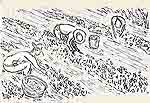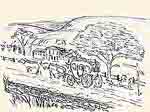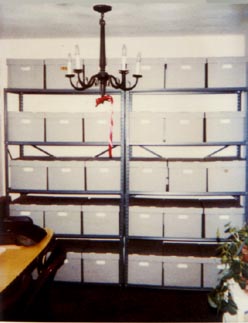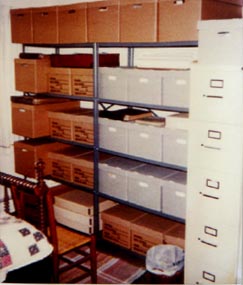|
Genesee Vignettes
Personal Reflections on the Genesee River
A series of eighteen essays by
VIII. Grandma Cornell at Letchworth
One of the main reasons I had accepted the RIT job offer was the proximity
it gave me to Grandma Cornell. On visits with her in Campbell, I enjoyed
listening to the stories she was always willing to tell. Most were set
in the Southern Tier. But a few involved Rochester.
Her eldest son—my Dad's older brother (and Aunt Dotty's first husband)—lived
in Rochester before moving to a house on Keuka Lake. I have fond memories
of visits with my cousins on the lake, but I don't have clear recollections
of earlier visits with them. Nevertheless—as Grandma reminded me—such
visits had taken place, so that my relationship with the Genesee Valley
involved more than just the experiences I've accumulated since my arrival
in 1982.
Contact with Grandma also showed me another kind of "Genesee vignette"
I could write. In addition to my childhood visits to the area, there were
her personal experiences—which now came to me through her stories.
For example, as a schoolteacher she had attended occasional teachers'
meetings in Rochester and had spent some of her free time shopping at
Sibley's downtown.
Grandma's relationship to the Rochester area turned out to be complex.
Usually I'd visit her at her home. But there were times when Dad brought
her to visit me. On one such occasion—in 1984—we spent an
afternoon at the Genesee Country Museum, near Mumford, New York. The high
point for Grandma was a tour of the Hamilton House, which had once stood
on Main Street in Campbell:
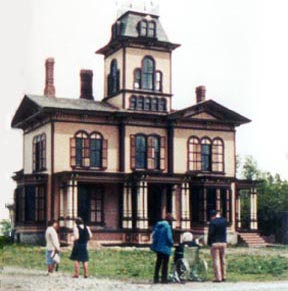
After another visit—in 1985—I took Grandma home via Geneseo,
New York. She had often told me about her experiences during the years
1913-1915, when she attended the state normal school—now SUNY Geneseo.
Her experiences had included walks to the falls of Fall Brook. But what
we made a point of locating on our trip together was "the Bolt Club,"
the house on Main Street where she had roomed.
I don't recall ever going to Letchworth with Grandma. Nor do I recall
ever hearing her talk about the park. But later I realized it's a place
she had visited long before I was born. During her college years she had
taken pictures using a Brownie camera—a direct descendent of the
cameras by which George Eastman had democratized the making of images.
Many of the pictures we had gone through together were Brownie snapshots.
After her death, several more surfaced—one of which showed her sitting
on a grassy hillside, holding a Brownie camera in her lap:

Also included in the new batch were two taken at Letchworth. Neither
was labeled. But in one of them Grandma was standing between two women
on a rock ledge below the Lower Falls, with the photographer looking downstream:
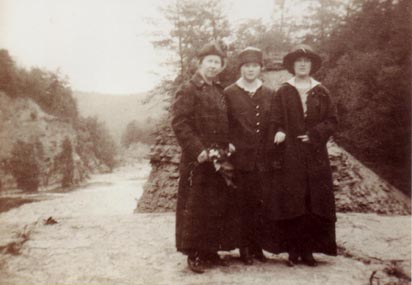
In the other, Grandma was seated:
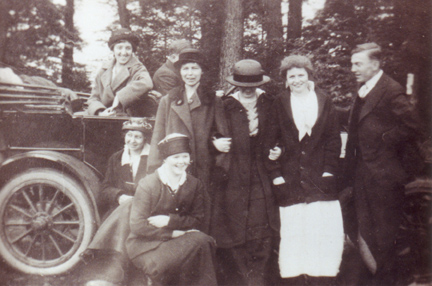
She also appeared in better focus and happier countenance. A comparison
of the clothing shows that the woman with her head bowed in the second
shot is the same as the one to Grandma's left in the first, which confirms
that the two pictures were taken on the same outing—an outing that
clearly included a stop at Letchworth.
IX. A Geological Orientation
In composing these vignettes I've found myself tending to cultivate a
geological orientation. Especially useful for this purpose have been the
popular writings of Bradford B. Van Diver and Thomas X. Grasso.2
But the source I now want to use is a more technical article, by a quartet
of authors, entitled "Morphogenesis of the Genesee Valley."3
If you examine a map of New York State, one of the Genesee's most prominent
features is a shift in its overall direction. Its upper reaches—from
its source in Pennsylvania to a point between Caneadea and Houghton, New
York—flow basically northwest, in parallel with the southeastward-flowing
Canisteo and Conhocton Rivers to the east. By contrast, the Genesee's
lower reaches flow northeast. The suggestion is that the current
watershed has been created out of what were once separate watersheds.
Or—in the geo-speak of the article:
Far from being an ideal valley system, an integral geomorphic
unit produced primarily by fluvial processes, the Genesee Valley involves
reaches with diverse origins and dissimilar histories.4
In surveying the twists and turns of my life, I've realized that it includes
a similar shift. Early in my senior year of high school I decided I needed
more time for my studies—especially for my physics class—so
I quit my part-time job at the Starkville Public Library and resigned
as president of my Explorer Post. More than the summer job I took after
graduating (as a junior counselor at one of the Fresh Air Fund camps near
Fishkill, New York) and more than my subsequent departure for Rhodes College,
the changes I made during the latter part of 1969 marked the real turning
point. Since then my life has flowed through a different watershed, one
that's defined by a distinctive kind of discipline—without which
I wouldn't have been able to choose a college major, attend graduate school,
or hold down a college teaching job.
Where the angular shift in the literal river occurs between Caneadea
and Houghton, the shift in the figurative river of my life resonates somehow
with the Mount Morris Dam. I had long noted that the dam is as old as
I am: it became operational at about the same time I was born, in late
1951. But more to the point is a functional likeness. Under normal circumstances,
something flows within me unimpeded, like the river under the dam. At
such times, my personality is tinted by colors from a spectrum of traits
that includes "honesty" and "naivete." But under conditions of stress,
the discipline I've cultivated since high school holds something back,
thereby imparting to my personality qualities from a different spectrum,
one that includes "up-tight brittleness" and "sullen mulishness."
Soon after that thought came to me, I went for another look. I was hoping
that a literal trip to the literal dam would clarify what the figurative
dam held back. But beyond the chain-link fence, all I could see was a
vast open space—defined below by the serpentine curves of the river,
above by soaring turkey buzzards, and across by the eroded strata of the
canyon walls:
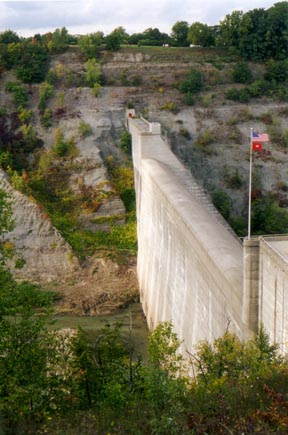
A literal visit, I concluded, wouldn't get the job done. There was no
way to avoid the figurative journey of writing about my Genesee memories.
For the downstream vignettes, the selection of events hadn't been a problem—which
surprised me somewhat, since my earliest local history writing had focused
on the Southern Tier. But writing about Letchworth was proving more difficult
than I had expected. Although I was making progress, I was uneasy with
the way I had chosen to move upstream from the dam: instead of confining
myself to recent events, I had shifted to events from my childhood and
from Grandma's youth.
As this line of thinking unfolded, I was reminded of a dream that dated
back to May 1990. Grandma had died in January, and for several weeks thereafter
I had lived in her house, putting her papers into boxes and generally
straightening the place up. Later still I had helped my parents take a
load of furniture home to Mississippi, and on the way back I had visited
Terry in Knoxville. Only after all that had I resumed "life as usual"
in my Rochester apartment—which is when the dream came:
I was driving along a country lane, lined with trees on either
side. At the end of the road and to the right I saw a roiling wall of
water, ten feet high and maybe thirty feet across. It was churning and
frothing, yet staying in place. I realized that the water level was much
higher than the surrounding countryside and was threatening to break through.
As quickly as I could, I turned around and drove back the way I had come.5
Right away I suspected that the roiling wall of water symbolized strong
emotions, so now—in the context of my Genesee vignettes—I
could guess what lay behind the figurative dam. Like the actual Mount
Morris Dam, the discipline I had cultivated since high school allowed
emotions of the usual sort to flow unimpeded. But whenever strong emotions
threatened, those floodwaters got held back—until they could be
safely released.
So far, so good. But could I pin down the specific emotions the wall
of water represented? In part, I suspected, I was threatened by grief.
But only in part. Grandma had lived a full life, and the two of us had
spent considerable time together. I missed her; I'll always miss her.
Yet through continued contact with people who knew her—family members
and non-family members alike—I still sensed her presence. Thus the
dream had to involve something else, as well.
Another unsettling feature of the dream image was the absence of a dam.
Strong emotions were indeed being held back, but not by any visible restraints.
What aspect of my life was like that? Here the essential clue turned out
to be the dimensions of the roiling wall. After returning to Rochester
in April 1990, I had purchased and assembled four sets of metal utility
shelves, on which I put Grandma's papers—sixty boxes' worth. Two
sets stood in my dining room and two in my bedroom. But the combined dimensions
were almost exactly those of the water in my dream:
Already I had been thinking of Grandma's papers in riverine terms. Her
interest in family history and local history meant that as she aged, historical
material flowed to her from many different sources, and because she lived
alone in a fairly large house—with a sturdy barn out back—she
possessed ample storage space.
Behind that dam the material pooled up, year after year. So deep did
the impounded waters become that Grandma was reluctant to allow anyone
but close family members into her house. On one of my visits, while she
was napping, I snapped a strictly unauthorized photo of her kitchen:
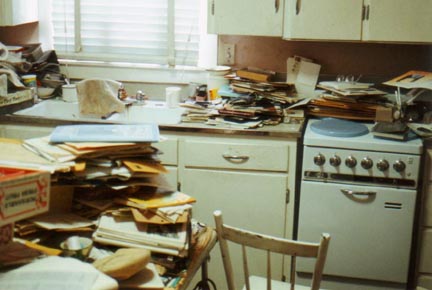
Except for the sink, for her chair seat, and for the front half of the
stove top (note the light-blue burner covers I had gotten her, to minimize
the danger of fire), virtually every horizontal surface was stacked with
papers. Such views were exactly what Grandma hadn't wanted others to see—and
if she had found out about my picture, I'd have been in hot water!
Like the kitchen, the other rooms of her house were filled with papers.
The same was true of the barn—where even a brief tour after Grandma's
death turned up material that interested my brother Don's eldest son,
Steven:

But Grandma's death represented a major dam break. In the months that
followed, her house and barn were sold and their contents distributed.
Fortunately, I was in the middle of a sabbatical at RIT and thus had
the time needed to create a new dam. The physical artifacts—furniture,
clothing, books, and so forth—were beyond me. Like the Genesee floodwaters
referred to in the title of Ruth Rosenberg-Naparsteck's book, the physical
artifacts were "runnin' crazy."6 They rushed by so fast I scarcely
noticed where they ended up. But because I wanted to use them for family
and local history projects, I was determined to keep the papers together.
Proceeding one handful at a time, I'd use a portable vacuum cleaner to
remove the dust. Then I'd put the dusted handful into a file folder and
put the folder into a box. When the box was full, I'd take it upstairs
and add it to the growing stack in one of the bedrooms. In early March,
Uncle John (Dad's younger brother) and I loaded all the boxes onto his
pickup and drove them to Aunt Dotty's, for temporary storage. Then after
my return to Rochester I rented a van and brought them to my apartment.
In effect, what I had done was to create an archival collection like
the ones I had used in the Library of Congress and elsewhere for my history
of science research. Until then my work with such sources had been emotionally
low-keyed. But my dream served as a powerful notice that the archival
boxes I saw each night when I turned in were actually quite different
from the archival boxes I was accustomed to using. Yes, I had created
a new dam; Grandma's papers were now held back by a sturdy arrangement
of file folders, archival boxes, and metal shelves. Yet I wasn't free
to treat that material in an emotionally neutral way. Behind the silent
rows of gray and brown boxes lay the churning and frothing I had seen
in my dream.
Compounding my uneasiness was the limited extent of my previous local
history writing. While Grandma was living, I kept such work to a minimum;
my visits with her came first. Along the way, I sensed the richness of
the material. But not until after processing her papers, did I see the
full extent of the task I had undertaken—and its vastness terrified
me.
Only now am I feeling comfortable enough to reflect on all this, and
the main reason is my regular participation in the Bath Area Writers Group.
After Grandma's death, I began writing short essays for presentation at
their monthly meetings, and from time to time I've revised my essays for
publication in The Crooked Lake Review. Slowly the rising volume
of finished work has taken the edge off my fears—and given me a
new perspective on my 1990 dream.
Here, finally, the geology article about the Genesee assumes its full
importance. "Fluvial modification," the authors noted, "though geologically
dominant at present has only begun to produce in the Genesee Valley the
geomorphic coherence toward which undisturbed hydrologic basins evolve."7
Or—to translate their geo-speak—the changes being wrought
by the river today have only begun transforming the separate watersheds
of past eras into a single, coherent system.
Apparently I don't live in a world that allows me to develop, from birth
to death, as an entirely new river. My life isn't emerging as an "undisturbed
hydrologic basin." Yet the kind of writing I'm doing in these essays turns
out to be a process of "fluvial modification" that's slowly imparting
"geomorphic coherence" to my life. Or—to return to the passage quoted
earlier—the "fluvial processes" of my writing are slowly creating
"an integral geomorphic unit" out of what previously had been separate
watersheds.
Whether I find myself in the terrain defined by my disciplined academic
work, or in the terrain defined by my childhood interests and experiences,
or in the terrain defined by Grandma's past—no matter what the terrain—I
now understand that integration, coherence, and unity will, in fact, come.
Through my writing I'll be able to make the various fragments whole. In
that sense, I now see that my 1990 dream offered as much a promise as
a threat.
Illustrations supplied by the author.
Notes
2. Bradford B.. Van
Diver, Roadside Geology of New York (Missoula, MT: Mountain
Press, 1985); and Thomas X. Grasso, "Geology and Industrial History
of the Rochester Gorge," Rochester History, Vol. 54, No. 4
(Fall 1992), pp. 3-43; and Vol. 55, No. 1 (Winter 1993), pp. 3-35.
3. Ernest H. Muller, Duane D. Braun, Richard
A. Young, and Michael P. Wilson, "Morphogenesis of the Genesee Valley,"
Northeastern Geology, Vol. 10 (1988), pp. 112-133.
4. Muller, et al., p. 112.
5. Paraphrase of Dream Notes for 26 May 1990.
6. Ruth Rosenberg-Naparsteck (with Edward
P. Curtis, Jr.), Runnin' Crazy: A Portrait of the Genesee River
(Virginia Beach, VA: Donning Co., 1996).
7. Muller et al., p. 112.
| 